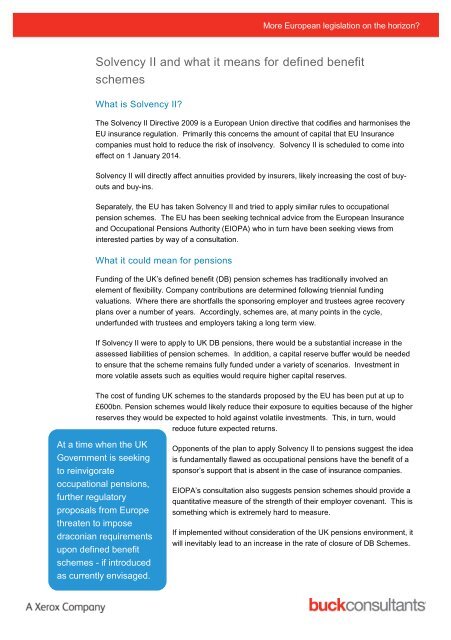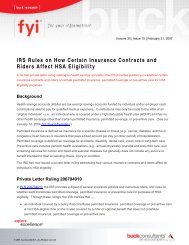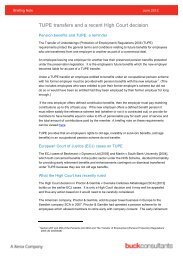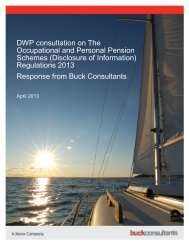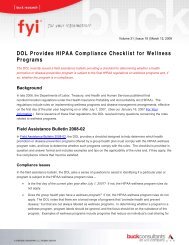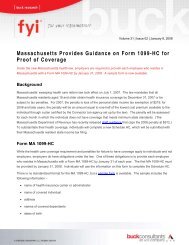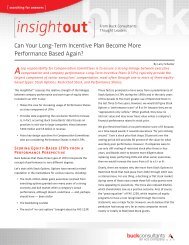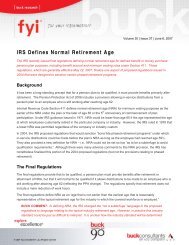Solvency II and what it means for defined benefit schemes
Solvency II and what it means for defined benefit schemes
Solvency II and what it means for defined benefit schemes
- No tags were found...
You also want an ePaper? Increase the reach of your titles
YUMPU automatically turns print PDFs into web optimized ePapers that Google loves.
More European legislation on the horizon?<strong>Solvency</strong> <strong>II</strong> <strong>and</strong> <strong>what</strong> <strong>it</strong> <strong>means</strong> <strong>for</strong> <strong>defined</strong> benef<strong>it</strong><strong>schemes</strong>What is <strong>Solvency</strong> <strong>II</strong>?The <strong>Solvency</strong> <strong>II</strong> Directive 2009 is a European Union directive that codifies <strong>and</strong> harmonises theEU insurance regulation. Primarily this concerns the amount of cap<strong>it</strong>al that EU Insurancecompanies must hold to reduce the risk of insolvency. <strong>Solvency</strong> <strong>II</strong> is scheduled to come intoeffect on 1 January 2014.<strong>Solvency</strong> <strong>II</strong> will directly affect annu<strong>it</strong>ies provided by insurers, likely increasing the cost of buyouts<strong>and</strong> buy-ins.Separately, the EU has taken <strong>Solvency</strong> <strong>II</strong> <strong>and</strong> tried to apply similar rules to occupationalpension <strong>schemes</strong>. The EU has been seeking technical advice from the European Insurance<strong>and</strong> Occupational Pensions Author<strong>it</strong>y (EIOPA) who in turn have been seeking views frominterested parties by way of a consultation.What <strong>it</strong> could mean <strong>for</strong> pensionsFunding of the UK’s <strong>defined</strong> benef<strong>it</strong> (DB) pension <strong>schemes</strong> has trad<strong>it</strong>ionally involved anelement of flexibil<strong>it</strong>y. Company contributions are determined following triennial fundingvaluations. Where there are shortfalls the sponsoring employer <strong>and</strong> trustees agree recoveryplans over a number of years. Accordingly, <strong>schemes</strong> are, at many points in the cycle,underfunded w<strong>it</strong>h trustees <strong>and</strong> employers taking a long term view.If <strong>Solvency</strong> <strong>II</strong> were to apply to UK DB pensions, there would be a substantial increase in theassessed liabil<strong>it</strong>ies of pension <strong>schemes</strong>. In add<strong>it</strong>ion, a cap<strong>it</strong>al reserve buffer would be neededto ensure that the scheme remains fully funded under a variety of scenarios. Investment inmore volatile assets such as equ<strong>it</strong>ies would require higher cap<strong>it</strong>al reserves.The cost of funding UK <strong>schemes</strong> to the st<strong>and</strong>ards proposed by the EU has been put at up to£600bn. Pension <strong>schemes</strong> would likely reduce their exposure to equ<strong>it</strong>ies because of the higherreserves they would be expected to hold against volatile investments. This, in turn, wouldreduce future expected returns.At a time when the UKGovernment is seekingto reinvigorateoccupational pensions,further regulatoryproposals from Europethreaten to imposedraconian requirementsupon <strong>defined</strong> benef<strong>it</strong><strong>schemes</strong> - if introducedas currently envisaged.Opponents of the plan to apply <strong>Solvency</strong> <strong>II</strong> to pensions suggest the ideais fundamentally flawed as occupational pensions have the benef<strong>it</strong> of asponsor’s support that is absent in the case of insurance companies.EIOPA’s consultation also suggests pension <strong>schemes</strong> should provide aquant<strong>it</strong>ative measure of the strength of their employer covenant. This issomething which is extremely hard to measure.If implemented w<strong>it</strong>hout consideration of the UK pensions environment, <strong>it</strong>will inev<strong>it</strong>ably lead to an increase in the rate of closure of DB Schemes.
More European legislation on the horizon?What is likely to happen?A good deal of uncertainty still surrounds the proposal to apply <strong>Solvency</strong> <strong>II</strong> to UK pensions.The EU has indicated that the proposals could at least be watered down. Whilst the wh<strong>it</strong>epaper on pensions produced by the EC suggests <strong>it</strong> will continue to work on legislation <strong>for</strong> thepensions industry (IORP) <strong>it</strong> has said that this does not necessarily mean pensions will besubject to the exact same rules as <strong>Solvency</strong> <strong>II</strong>. The EU has said <strong>Solvency</strong> <strong>II</strong> has caused themto look at pensions but <strong>it</strong> does not mean they will copy <strong>it</strong>.The current EU proposals relieve DB pension funds from the need to provide a cap<strong>it</strong>al reservebuffer. Instead a “holistic balance sheet” approach is proposed. EIOPA favours allowingsponsor covenants <strong>and</strong> Pension Protection Fund guarantees to be taken into account in theholistic balance sheet approach. A press release says this will “enable IORPs to take intoaccount the various adjustment mechanisms (cond<strong>it</strong>ional indexation, reduction of accruedrights) <strong>and</strong> secur<strong>it</strong>y mechanisms (regulatory own funds, sponsor support, pension protectionfund) in an explic<strong>it</strong> way.”The full details of this holistic balance sheet approach are still open to discussion <strong>and</strong> yet to befully finalised.The new proposals have done l<strong>it</strong>tle to stem the flow of cr<strong>it</strong>icism <strong>for</strong> the wholeidea <strong>and</strong> pol<strong>it</strong>ical pressure could still result in the proposals being shelved orat least further amended be<strong>for</strong>e they are implemented.Find out moreIf you would like to discuss the content of this briefing note <strong>and</strong> how <strong>it</strong> will impact yourorganisation, please contact:Gary Crock<strong>for</strong>d, Techical Services Manager.+44 (0)20 7429 1274 or gary.crock<strong>for</strong>d@buckconsultants.comIn<strong>for</strong>mation contained in this briefing note is of a general nature only; <strong>it</strong> represents our underst<strong>and</strong>ing of current (<strong>and</strong>proposed) law <strong>and</strong> practice but should not be relied upon as advice in any specific s<strong>it</strong>uation.© 2012 Buck Consultants Lim<strong>it</strong>ed. All rights reserved2


